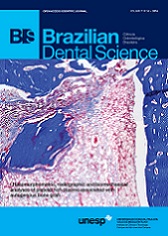Evaluation of stabilizing plate therapeutic effects of different types of temporomandibular disorders - painful evolution of patients treated in a reference center
DOI:
https://doi.org/10.14295/bds.2014.v17i4.1011Abstract
Objective: Evaluation of the symptomatic outcome of patients of various types of TMD treated exclusively with stabilizing plate for a period of three months patients comparing painful muscle and joint symptoms , and clinical aspects , both before and after treatment periods . Material and methods: A retrospective study of medical records of 628 rescue the last ten years (2004-2013 ) of subjects treated at the Serviço de Diagnóstico e Orientação a pacientes com Desordem Temporomandibular (Serviço ATM), Faculty of Dentistry/UFJF. The sample was divided into subgroups distinct diagnoses, in which the evaluation of symptomatic progression of patients through the analysis of pain scores, measuring the amplitude of mouth opening and the presence of joint sounds was performed. Data were obtained in early stages and after treatment with stabilizing plate. Results: The group of individuals diagnosed with muscular disorder (47.45% ) and those with multiple diagnoses ( 3.34 % ) had a higher prevalence of chronic orofacial pain ( 90.26 % and 95.23 % ) . The remission of painful symptoms was visible in groups accompanied by increased amplitude of mouth opening. Additional way, we obtained reduction joint sounds in patients with intracapsular and degenerative disorders, respectively. Conclusion: The stabilizing plate has shown efficacy in various types of temporomandibular disorders evaluated. However, in an attempt to encompass all etiological factors in therapy, emphasizes the importance of multidisciplinary therapies for the treatment of temporomandibular disorders.
Downloads
Downloads
Additional Files
Published
How to Cite
Issue
Section
License
Brazilian Dental Science uses the Creative Commons (CC-BY 4.0) license, thus preserving the integrity of articles in an open access environment. The journal allows the author to retain publishing rights without restrictions.
=================




























